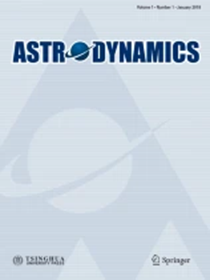用于高保真天体动力学数值传播的工具
IF 2.7
1区 物理与天体物理
Q2 ASTRONOMY & ASTROPHYSICS
引用次数: 1
摘要
本文提出了一种用于高保真天体动力学数值传播的工具,称为PHiFA。通过考虑各种类型的微扰力和力矩,建立了空间物体轨道-姿态耦合动力学模型。计算表面力的方法有两种:面积矩阵法和梁法。光束法更精确,因为它将源介质(如阳光和空气动力学风)和目标表面分别离散为多个射线和有限元,然后累积每次撞击的效果。PHiFA工具使用3U立方体卫星模型和已失效的欧洲环境卫星(Envisat)模型进行了测试和验证。本文章由计算机程序翻译,如有差异,请以英文原文为准。
PHiFA—A tool for numerical propagation of high-fidelity astrodynamics
This paper presents a tool for the numerical propagation of high-fidelity astrodynamics, called PHiFA. The coupled orbit-attitude dynamics for space objects are modeled by considering various types of perturbative forces and torques. Two methods have been implemented to calculate the surface forces: the area matrix method and the beam method. The beam method is more precise as it discretizes the source media (e.g., sunlight and aerodynamic wind) and the surface of the target into multiple rays and finite elements, respectively, and then accumulates the effect of each hit. The PHiFA tool was tested and validated using a 3U CubeSat model and the defunct European environment satellite (Envisat) model.
求助全文
通过发布文献求助,成功后即可免费获取论文全文。
去求助
来源期刊

Astrodynamics
Engineering-Aerospace Engineering
CiteScore
6.90
自引率
34.40%
发文量
32
期刊介绍:
Astrodynamics is a peer-reviewed international journal that is co-published by Tsinghua University Press and Springer. The high-quality peer-reviewed articles of original research, comprehensive review, mission accomplishments, and technical comments in all fields of astrodynamics will be given priorities for publication. In addition, related research in astronomy and astrophysics that takes advantages of the analytical and computational methods of astrodynamics is also welcome. Astrodynamics would like to invite all of the astrodynamics specialists to submit their research articles to this new journal. Currently, the scope of the journal includes, but is not limited to:Fundamental orbital dynamicsSpacecraft trajectory optimization and space mission designOrbit determination and prediction, autonomous orbital navigationSpacecraft attitude determination, control, and dynamicsGuidance and control of spacecraft and space robotsSpacecraft constellation design and formation flyingModelling, analysis, and optimization of innovative space systemsNovel concepts for space engineering and interdisciplinary applicationsThe effort of the Editorial Board will be ensuring the journal to publish novel researches that advance the field, and will provide authors with a productive, fair, and timely review experience. It is our sincere hope that all researchers in the field of astrodynamics will eagerly access this journal, Astrodynamics, as either authors or readers, making it an illustrious journal that will shape our future space explorations and discoveries.
 求助内容:
求助内容: 应助结果提醒方式:
应助结果提醒方式:


